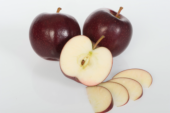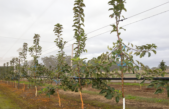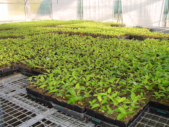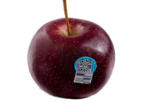






























































































































































































ANABP 01 History
More than 20 years of research and development by the Department of Agriculture and Food, Western Australia, culminated in the first commercial planting of ANABP 01 apple trees in 2014. ANABP 01 resulted from a 1992 cross between Royal Gala and the well-known Western Australian apple variety Cripps Red (marketed as Sundowner™ in most places but Joya™ in Europe) at the Stoneville Research Station, before the first 2 trees were sent to the current DAFWA research centre at Manjimup for evaluation and development. It is 100% non-GMO variety. The variety is protected by Plant Breeders Rights, and is owned by the Western Australian Agriculture Authority. Fruit West Co-operative is the exclusive licensee to manage the commercialisation of the ANABP 01 variety and its fruit in Australia. Fruit of the ANABP 01 variety colours well and the tree is generally productive and well suited to Australian orchard and fruit handling management systems. ANABP 01 trees produce regular crops of medium to large size fruit that is not prone to surface cracking, bitter pit, superficial scald or internal disorders. It is a mid to late season variety that performs well in regions with long warm to hot summers. Stringent grading and quality standards are applied to ensure only premium ANABP 01 fruit is released to the market under the Bravo™ apple brand. Individual pieces of fruit will be medium to large in size depending on crop load and seasonal factors. The average size is between 75 and 85 mm in diameter and the average weight ranges between 180 and 245 grams.Breeding process:
The apple breeding program led by the Department of Agriculture and Food, Western Australia at the Manjimup Horticulture Research Institute with the support of Horticulture Innovation Australia, uses conventional breeding methods involving hand and spray pollination. The cross to create the ANABP 01 apple variety, was made in 1992 using as parent stock, the Cripps Red (marketed as Sundowner™ in most places but Joya™ in Europe) and Royal Gala apple varieties. Thousands of seedlings were produced every year during the breeding program with about 1:400 making it to the second stage of Department of Agriculture and Food testing in the systematic quest for superior fruit for the benefit growers and consumers. Second stage of development involved evaluation including field and laboratory measurements of important characteristics such as fruit set, yield, sugar and acid control, flesh pressures and keeping ability. Sensory evaluation, a system of rating appearance and eating characteristics, was also undertaken to assess consumer reaction to the fruit. Superior selections from the second stage are promoted for limited, controlled release for evaluation purposes on third-party sites including Australian Pome Fruit Improvement Program sites. To reach the release stage, a selection has to successfully progress through these stages of evaluation and be superior to existing varieties or novel in the marketplace.Tree Growth:
ANABP 01 apple trees have medium vigour and a spreading growth habit with wide branch angles similar to Cripps Red. The development of fruiting laterals is sufficient but not prolific and tree shape suggests that it would be suited to a range of rootstocks and tree training systems. Fruit ripens towards the end of the apple harvest season - about 27 days after Golden Delicious and 14 days before Cripps Pink apples. In Manjimup, Western Australia, this is normally around mid-April but is dependent on seasonal conditions. ANABP 01 apples respond well to good temperature and storage management. Fruit should be pre-cooled to 2–4°C within 24 hours of harvest. Optimum storage temperature is 0 to 0.5°C.




Find out more about:







© Copyright Fruit West Co-operative Ltd. 2021
ANABP 01 History
More than 20 years of research and development by the Department of Agriculture and Food, Western Australia, culminated in the first commercial planting of ANABP 01 apple trees in 2014. ANABP 01 resulted from a 1992 cross between Royal Gala and the well-known Western Australian apple variety Cripps Red (marketed as Sundowner™ in most places but Joya™ in Europe) at the Stoneville Research Station, before the first 2 trees were sent to the current DAFWA research centre at Manjimup for evaluation and development. It is 100% non-GMO variety. The variety is protected by Plant Breeders Rights, and is owned by the Western Australian Agriculture Authority. Fruit West Co-operative is the exclusive licensee to manage the commercialisation of the ANABP 01 variety and its fruit in Australia. Fruit of the ANABP 01 variety colours well and the tree is generally productive and well suited to Australian orchard and fruit handling management systems. ANABP 01 trees produce regular crops of medium to large size fruit that is not prone to surface cracking, bitter pit, superficial scald or internal disorders. It is a mid to late season variety that performs well in regions with long warm to hot summers. Stringent grading and quality standards are applied to ensure only premium ANABP 01 fruit is released to the market under the Bravo™ apple brand. Individual pieces of fruit will be medium to large in size depending on crop load and seasonal factors. The average size is between 75 and 85 mm in diameter and the average weight ranges between 180 and 245 grams.Breeding process:
The apple breeding program led by the Department of Agriculture and Food, Western Australia at the Manjimup Horticulture Research Institute with the support of Horticulture Innovation Australia, uses conventional breeding methods involving hand and spray pollination. The cross to create the ANABP 01 apple variety, was made in 1992 using as parent stock, the Cripps Red (marketed as Sundowner™ in most places but Joya™ in Europe) and Royal Gala apple varieties. Thousands of seedlings were produced every year during the breeding program with about 1:400 making it to the second stage of Department of Agriculture and Food testing in the systematic quest for superior fruit for the benefit growers and consumers. Second stage of development involved evaluation including field and laboratory measurements of important characteristics such as fruit set, yield, sugar and acid control, flesh pressures and keeping ability. Sensory evaluation, a system of rating appearance and eating characteristics, was also undertaken to assess consumer reaction to the fruit. Superior selections from the second stage are promoted for limited, controlled release for evaluation purposes on third-party sites including Australian Pome Fruit Improvement Program sites. To reach the release stage, a selection has to successfully progress through these stages of evaluation and be superior to existing varieties or novel in the marketplace.Tree Growth:
ANABP 01 apple trees have medium vigour and a spreading growth habit with wide branch angles similar to Cripps Red. The development of fruiting laterals is sufficient but not prolific and tree shape suggests that it would be suited to a range of rootstocks and tree training systems. Fruit ripens towards the end of the apple harvest season - about 27 days after Golden Delicious and 14 days before Cripps Pink apples. In Manjimup, Western Australia, this is normally around mid-April but is dependent on seasonal conditions. ANABP 01 apples respond well to good temperature and storage management. Fruit should be pre-cooled to 2–4°C within 24 hours of harvest. Optimum storage temperature is 0 to 0.5°C.




















